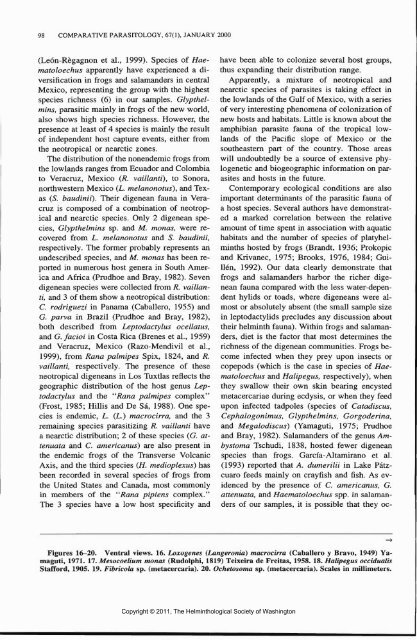Comparative Parasitology 67(1) 2000 - Peru State College
Comparative Parasitology 67(1) 2000 - Peru State College
Comparative Parasitology 67(1) 2000 - Peru State College
Create successful ePaper yourself
Turn your PDF publications into a flip-book with our unique Google optimized e-Paper software.
COMPARATIVE PARASITOLOGY, <strong>67</strong>(1), JANUARY <strong>2000</strong><br />
(Leon-Regagnon et al., 1999). Species of Haematoloechus<br />
apparently have experienced a diversification<br />
in frogs and salamanders in central<br />
Mexico, representing the group with the highest<br />
species richness (6) in our samples. Glypthelmins,<br />
parasitic mainly in frogs of the new world,<br />
also shows high species richness. However, the<br />
presence at least of 4 species is mainly the result<br />
of independent host capture events, either from<br />
the neotropical or nearctic zones.<br />
The distribution of the nonendemic frogs from<br />
the lowlands ranges from Ecuador and Colombia<br />
to Veracruz, Mexico (R. vaillanti), to Sonora,<br />
northwestern Mexico (L. melanonotus), and Texas<br />
(S. baudinii). Their digenean fauna in Veracruz<br />
is composed of a combination of neotropical<br />
and nearctic species. Only 2 digenean species,<br />
Glypthelmins sp. and M. monas, were recovered<br />
from L. melanonotus and S. baudinii,<br />
respectively. The former probably represents an<br />
undescribed species, and M. monas has been reported<br />
in numerous host genera in South America<br />
and Africa (Prudhoe and Bray, 1982). Seven<br />
digenean species were collected from R. vaillanti,<br />
and 3 of them show a neotropical distribution:<br />
C. rodriguezi in Panama (Caballero, 1955) and<br />
G. parva in Brazil (Prudhoe and Bray, 1982),<br />
both described from Leptodactylus ocellatus,<br />
and G. facioi in Costa Rica (Brenes et al., 1959)<br />
and Veracruz, Mexico (Razo-Mendivil et al.,<br />
1999), from Rana palmipes Spix, 1824, and R.<br />
vaillanti, respectively. The presence of these<br />
neotropical digeneans in Los Tuxtlas reflects the<br />
geographic distribution of the host genus Leptodactylus<br />
and the "Rana palmipes complex"<br />
(Frost, 1985; Hillis and De Sa, 1988). One species<br />
is endemic, L. (L.) macrocirra, and the 3<br />
remaining species parasitizing R. vaillanti have<br />
a nearctic distribution; 2 of these species (G. attenuata<br />
and C. americanus) are also present in<br />
the endemic frogs of the Transverse Volcanic<br />
Axis, and the third species (H. medioplexus) has<br />
been recorded in several species of frogs from<br />
the United <strong>State</strong>s and Canada, most commonly<br />
in members of the "Rana pipiens complex."<br />
The 3 species have a low host specificity and<br />
have been able to colonize several host groups,<br />
thus expanding their distribution range.<br />
Apparently, a mixture of neotropical and<br />
nearctic species of parasites is taking effect in<br />
the lowlands of the Gulf of Mexico, with a series<br />
of very interesting phenomena of colonization of<br />
new hosts and habitats. Little is known about the<br />
amphibian parasite fauna of the tropical lowlands<br />
of the Pacific slope of Mexico or the<br />
southeastern part of the country. Those areas<br />
will undoubtedly be a source of extensive phylogenetic<br />
and biogeographic information on parasites<br />
and hosts in the future.<br />
Contemporary ecological conditions are also<br />
important determinants of the parasitic fauna of<br />
a host species. Several authors have demonstrated<br />
a marked correlation between the relative<br />
amount of time spent in association with aquatic<br />
habitats and the number of species of platyhelminths<br />
hosted by frogs (Brandt, 1936; Prokopic<br />
and Krivanec, 1975; Brooks, 1976, 1984; Guillen,<br />
1992). Our data clearly demonstrate that<br />
frogs and salamanders harbor the richer digenean<br />
fauna compared with the less water-dependent<br />
hylids or toads, where digeneans were almost<br />
or absolutely absent (the small sample size<br />
in leptodactylids precludes any discussion about<br />
their helminth fauna). Within frogs and salamanders,<br />
diet is the factor that most determines the<br />
richness of the digenean communities. Frogs become<br />
infected when they prey upon insects or<br />
copepods (which is the case in species of Haematoloechus<br />
and Halipegus, respectively), when<br />
they swallow their own skin bearing encysted<br />
metacercariae during ecdysis, or when they feed<br />
upon infected tadpoles (species of Catadiscus,<br />
Cephalogonimus, Glypthelmins, Gorgoderina,<br />
and Megalodiscus) (Yamaguti, 1975; Prudhoe<br />
and Bray, 1982). Salamanders of the genus Ambystoma<br />
Tschudi, 1838, hosted fewer digenean<br />
species than frogs. Garcia-Altamirano et al.<br />
(1993) reported that A. dumerilii in Lake Patzcuaro<br />
feeds mainly on crayfish and fish. As evidenced<br />
by the presence of C. americanus, G.<br />
attenuata, and Haematoloechus spp. in salamanders<br />
of our samples, it is possible that they oc-<br />
Figures 16-20. Ventral views. 16. Loxogenes (I^angeronia) macrocirra (Caballero y Bravo, 1949) Yamaguti,<br />
1971. 17. Mesocoelium monas (Rudolphi, 1819) Teixeira de Freitas, 1958. 18. Halipegus occidualis<br />
Stafford, 1905. 19. Fibricola sp. (inetacercaria). 20. Ochetosoma sp. (metacercaria). Scales in millimeters.<br />
Copyright © 2011, The Helminthological Society of Washington
















